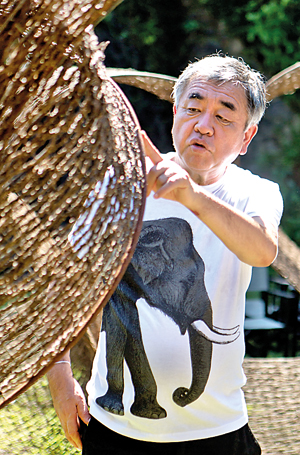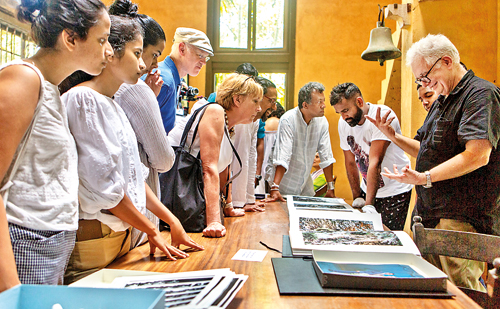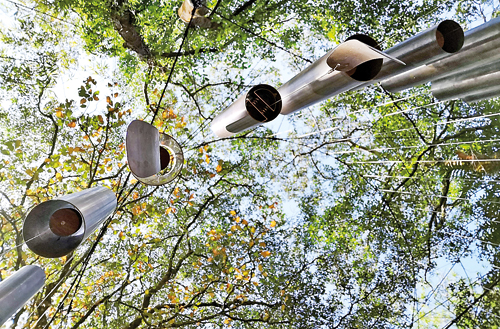Gifts of art for a master garden
Lunuganga- the Italian-tropical garden where a puckish Hindu Pan cavorts with a leopard and Greek youths- was Geoffrey Bawa’s greatest gift to his island home. It is, above all, a place that inspires- from Michael Ondaatje who used its deep sepia peace and beauty to leaven his tale of wartime grimness in the novel Anil’s Ghost, to Laki Senanayake who left, on an old wall, a typically epic mural with a patina of green moss: an ancient Hindu Guernica- only evoking the splendour of battle instead of destruction.

Making waves: Internationally acclaimed Japanese architect Kengo Kuma’s (right)) tsunami wave ‘Kitul Ami’ . Pix by Sameera Weerasekera
Now the Lunuganga Trust brings us The Gift- as part of the Geoffrey Bawa centenary celebrations held from July 2019 to July 2020. It looks at this garden as a gift by Bawa to everyone. We can all take our sip of inspiration- whoever we are.
As a trigger, three internationally known artists have been invited to strike their own conversations with the garden and this house that have- especially for Sri Lankans- the effect of quenching a deep aesthetic thirst.
The three artists have set up their installations in Lunuganga.
The first, Kitul-Ami, is by architect Kengo Kuma from Tokyo- the man who designed Scotland’s Victoria and Albert Museum in Dundee. Following Shayari de Silva, curator for The Gift, and Channa Daswatte, adviser to the Trust, we walk down mossy stone steps and groves of trees till, by the lake, we find a tsunami wave seemingly made of bamboo mesh.
 Only, says Kuma, this installation is made of kitul- not bamboo. The circle of waves has been hand-woven from kitul and steel. It was inspired by Bawa’s steel furniture at Lunuganga and Kandalama- which curve beautifully and are transparent- but also inspired by the garden itself, and the traditional Japanese tea house. So the formula is the pure Bawa one- of “using tradition to look to the future”.
Only, says Kuma, this installation is made of kitul- not bamboo. The circle of waves has been hand-woven from kitul and steel. It was inspired by Bawa’s steel furniture at Lunuganga and Kandalama- which curve beautifully and are transparent- but also inspired by the garden itself, and the traditional Japanese tea house. So the formula is the pure Bawa one- of “using tradition to look to the future”.
This wave also works as a sundial as the light changes, but its primary function is spiritual. “It should be like a Zen temple- where people can, from within, see and feel nature” says Kuma.
“Visitors can sit and meditate inside- and feel the harmony of nature.”
We meander past Bentota Lake to the second installation by the lotus pond- where the giant bamboo grove whispers and a stone sundial adds to the Greco-Italian feel. The classical name of this installation- which is a gigantic wind-chime- is Zephyrus’ Breath- named after the Greek god of the west wind.
The soft tinkling made by the chime is beautiful. Originally, this was done by artist Lee Mingwei at a great pink Scottish mansion- the Mount Stuart House- in whose grounds four ancient lime trees allowed a spider’s web of a mesh to be built some 30 feet above ground- onto which would be suspended the circle of great tubular bells.
In Lunuganga however only three trees could be found forming a similar pattern- so slight changes were done. A more intrinsic alteration was that the bells were made of brass here instead of the original copper.
Though born of practical considerations of availability, the swapping of the metals gave Zephyrus’ Breath a local ‘tang’ (as it were)- taking you back to the shrine of Kataragama; as indigenous among the kumbuk trees as copper would have been in the old Caledonian woodland setting.
The visitor has to stand in the middle of the wind-chime to experience the magic. The tubular bells are stirred by the wind- which comes from the forest gently, the sound growing louder and then slowly fading away- leaving what Lee calls a ‘shimmer’. “The sound follows the footsteps of the wind,” he says.
It is a “gift of sound”- says Shayari- but Lee was also engaging with the garden visually. From an upper vantage, you see that its circle is echoed by those of the nearby sundial, and the bamboo grove.
Leaving the silver strains of the west wind, we take another winding mossy staircase to the Sandella pavilion- the shadowy mezzanine made from salvaged parts of old buildings and a chessboard floor.
The exquisite antiques once kept on its table are no longer there- instead a box of black and white prints and a box of gloves to handle them with- and a wrapped gift.
Enter Dominic Sansoni who created the third installation, Symbiotic Organism- an apt title for work that has grown as the garden grew. He has sheaves of monochrome photos of the garden starting from 1977, the year when, he reveals, he was made a photographer by Bawa himself.

A devoted journey with his camera: Dominic Sansoni’s Symbiotic Organism
Back for a holiday from England, teenaged Dominic was given a Leica M3 by Bawa. Let loose in the garden Dominic would record the poetry of shadow and light.
Bawa’s own view of the garden was of tonality- and this was transferred to Dominic who finds it hard to capture Lunuganga in colour. Hence the densely shadowed black and white images of pavilions and the Greek statues against lake and grove.
On the Sandella walls are more black and whites- portraits of the gardeners who had kept the garden wild but manicured- a team who, now, have reason to be grateful to Dominic and his 1990 book done with Christoph Bon and Bawa- called Lunuganga- where he collated images approved by Bawa. The manager of the garden Isuru now keeps this book in his cellphone to consult in regard to all restoration.

Blowing in the wind: Zephyrus’ Breath by Lee Mingwei
But Dominic’s truest gift was waiting to be unwrapped on the table. Devoted to the garden “where at each visit (he) finds something new”, he has put together a pictorial record of the lichen in Lunuganga. A coffee table book whose portraits come in luminous to pastel to ashen gray, it is an exquisite work of art- the beauty of decay, as etched on to bark, wall and stone. Some look like fantastic African landscapes taken from the sky- others are nature’s abstract art.
Their timeless but flamboyant colours and textures bring to mind two artists of the Bawa set- Ena de Silva and Barbara Sansoni, though of course the lichen can also come in exotic neon greens and icy arctic blues unlike in Ena’s batiks.
A second set of installations will open in March at Lunuganga, and together they will go on till July- each a dialogue with Bawa that says ‘Thank You’ to the master for his gift, while engaging in the most dynamic of discussions with this garden- his masterpiece.


